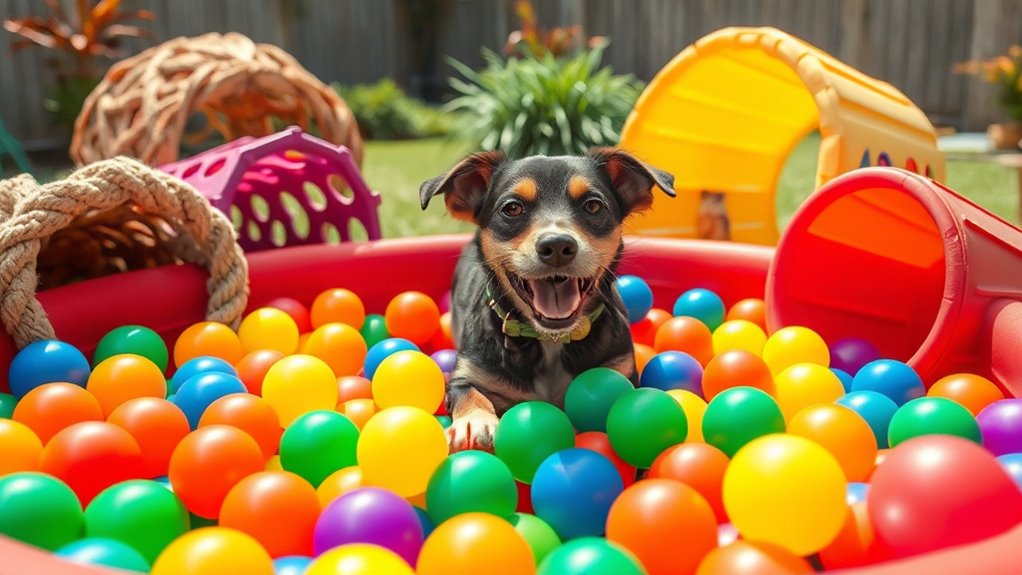Looking for DIY foraging toys to keep your pet mentally engaged? You can create fun, eco-friendly options using household items like toilet paper rolls, muffin tins, shoeboxes, or plastic bottles. Hide treats inside, cover with obstacles, or set up search activities to challenge your pet’s nose and problem-solving skills. These projects are cost-effective and promote natural instincts. Keep exploring for more creative ideas to enrich your furry friend’s playtime and mental stimulation.
Key Takeaways
- Use household recyclables like plastic bottles, cardboard, and paper towel rolls to create engaging puzzle toys with hidden treats.
- Incorporate holes, compartments, or layers in DIY toys to encourage scent tracking and problem-solving behaviors.
- Build snuffle mats from fleece strips or fabric scraps, hiding treats within layers to promote nose work and foraging.
- Craft treat-dispensing toys by filling toilet paper rolls or cardboard boxes with treats, then sealing or covering openings for added challenge.
- Reinforce homemade toys with durable, non-toxic materials, and supervise pets to ensure safety during foraging play.
Making a Toilet Tube Treat Dispenser

Creating a DIY toilet tube treat dispenser is a simple and effective way to keep your pet entertained. Start with an empty toilet paper or paper towel roll, and fill it with treats or spread a layer of peanut butter inside to motivate licking and dissection. To add a challenge, fold down or pinch the ends of the tube, making your pet work harder to access the treats. For longer-lasting mental stimulation, freeze the filled tube so it takes more effort to disassemble. This homemade treat dispenser turns a basic object into a fun, engaging DIY toy that encourages problem-solving. Incorporating visual appeal principles can also make the treats and the toy more visually stimulating and attractive to your pet. Always supervise your pet during play to prevent choking or ingestion of cardboard pieces. Use non-toxic, pet-safe materials to ensure safety while providing a stimulating, homemade activity. Additionally, choosing safe materials ensures the toy remains free from harmful chemicals and is durable enough for repeated use. Being mindful of pet safety helps prevent potential hazards during playtime.
Crafting a Muffin Tin Shell Game

To set up the Muffin Tin Shell Game, start by placing treats in some cups and covering them with balls or other objects. You can increase the challenge by covering more cups or using larger tins, encouraging your pet to problem-solve. Keep your pet engaged by varying the difficulty and offering plenty of encouragement as they learn to find the hidden treats. Incorporating self watering plant pots like varying the game difficulty can help improve your pet’s cognitive skills and overall experience. Additionally, adjusting the caffeine content in treats or toys can be a fun way to add an extra layer of challenge for your pet. Remember that engaging your pet with interactive toys can further boost their mental stimulation and keep them entertained. Introducing sound effects into the game setup can also heighten your pet’s interest and responsiveness.
Setting Up the Game
Start by filling some cups of a muffin tin with treats or kibble, leaving others empty to encourage your pet to search. This setup promotes natural searching behavior and adds an element of challenge. To hide the treats further, cover some cups with small balls or lids, making your pet work to uncover the hidden rewards. Place the muffin tin on the floor in a quiet, safe area to minimize distractions. As your pet becomes more proficient, you can reduce the number of treats in each cup or spread the cups farther apart to increase difficulty. Incorporating brain-stimulating activities like this foraging game can enhance your pet’s cognitive skills and overall well-being. Regularly engaging in such enrichment activities can help prevent boredom and destructive behaviors. Understanding the importance of mental stimulation can further motivate you to create diverse and engaging activities for your pet. Incorporating safe play principles ensures your pet’s safety during these activities. Remember to supervise your pet during the game to ensure safety and prevent any accidental swallowing or frustration. This simple setup turns a muffin tin into an engaging foraging activity that stimulates your pet’s scent detection and problem-solving skills. Awareness of pet enrichment benefits helps promote mental stimulation and overall well-being for your furry friend.
Increasing Difficulty Levels
Once your pet becomes comfortable with uncovering treats in an uncovered muffin tin, you can make the game more challenging by covering some or all of the cups with small balls or lids. This increases the difficulty, requiring your pet to remove obstacles to access the treats and engage in problem-solving. To enhance scent discrimination, reduce the number of baited cups over time, forcing your pet to rely more on scent rather than sight. Spread the cups farther apart to challenge their search and reach, boosting memory and tracking skills. Vary the placement and size of the cups or treats to keep the brain game fresh and prevent boredom. These adjustments help your pet develop sharper problem-solving abilities while making the game more stimulating. Additionally, applying skincare patches can be used as a calming tool to help pets relax during playtime. Incorporating training techniques such as positive reinforcement can further improve your pet’s cognitive skills and responsiveness during these games. Moreover, understanding the off-road environment can help optimize the placement and difficulty level of the challenges, making the activity even more engaging. Introducing breed-specific considerations can also tailor the game to better suit your pet’s natural instincts and preferences.
Tips for Engagement
Engaging your pet with a muffin tin shell game is both fun and effective when you vary the setup to keep their interest high. Start by placing treats or kibble under a few cups, then cover some with balls to promote scent tracking and problem-solving. Vary the placement and number of treats to gradually increase difficulty, which boosts mental stimulation and confidence. Use mini muffin tins for small breeds or puppies to make the game more accessible and prevent frustration. Initially, leave treats uncovered or only partly covered to help your pet build confidence. As they improve, increase the challenge by covering more cups. Always supervise play to ensure safety, and rotate the game regularly to maintain engagement and prevent boredom with your DIY toys.
Creating a Shoebox Hide and Seek Challenge

To create a shoebox hide and seek challenge, start by selecting a sturdy container and poking small holes in the lid for scent access. Place treats inside and hide the box among other objects to make your pet search more engaging. As your pet gets better, increase the difficulty by spreading out the boxes or covering some to encourage more scent tracking. Using a flat iron bike for outdoor activities can also help in creating a stimulating environment for your pet. Incorporating grocery savings strategies can help you afford more supplies for enriching activities.
Setting Up the Game
Begin by choosing a small container like an empty shoebox or similar with a lid. This DIY foraging toy encourages your pet to hunt for treats. To set up the game:
- Poke small holes in the lid to let your pet smell and access the treats inside.
- Bait the container with treats or kibble, then securely close the lid to prevent early snacking.
- Arrange multiple baited containers and empty ones on the floor, spacing them out to prompt your pet to use their nose and problem-solving skills.
- Incorporating different shapes and sizes of containers can also enhance the foraging experience and challenge your pet further.
- Using a variety of textile-inspired textures in your setup can stimulate your pet’s senses and make the game more engaging.
- Including safe household objects can diversify the environment and keep your pet mentally stimulated during play.
Increasing Search Difficulty
Enhancing the difficulty of a shoebox hide and seek game involves making subtle changes to challenge your pet’s scent detection and problem-solving skills. To increase search difficulty, start by reducing the number of baited containers and spacing them farther apart. Use smaller or more opaque containers, like yogurt tubs or covered boxes, to make scent detection more demanding. Poking fewer or smaller holes in container lids forces your pet to rely more on its nose. Spread the containers across different rooms or levels to add complexity and encourage thorough searching. For an extra challenge, incorporate multiple layers by stacking boxes or hiding containers inside other objects. These DIY adjustments boost mental stimulation, making the game more engaging and enriching your pet’s foraging experience.
Building a DIY Doggy Ball Pit

Creating a DIY doggy ball pit is a simple and engaging way to provide mental stimulation for your pet. To start, choose a small kiddie pool and fill it with plastic balls—making sure they’re non-toxic, durable, and large enough to prevent choking. Here are three steps to get you going:
- Hide dog treats or kibble inside the plastic balls to turn it into a fun foraging toy.
- Begin with fewer balls to help your dog feel comfortable, then gradually add more.
- Supervise your pet to prevent ingestion of small parts and ensure the plastic balls stay intact.
This homemade dog toy encourages problem-solving, slows fast eaters, and keeps your pup entertained while promoting mental stimulation.
Designing a Snuffle Mat From Household Items

Turning to another engaging way to stimulate your dog’s natural instincts involves crafting a snuffle mat from household items. You can easily make a snuffle mat by tying fleece strips into a rubber sink mat or similar surface, creating a textured area for foraging. Using household items like old towels, socks, or fabric scraps keeps it budget-friendly and eco-conscious. This DIY dog toy encourages mental stimulation by hiding treats within the layers or pockets you create, prompting your pet to use their nose and problem-solving skills. Regularly rotating treats and changing the hiding spots keeps your dog interested and prevents boredom. Recycling bin finds make it simple to craft effective foraging toys, making this a fun, sustainable project for your furry friend.
Assembling a Snuffle Ball for Foraging Fun

Assembling a snuffle ball for foraging fun involves selecting durable fabrics like denim or fleece and sewing them into a spherical shape with multiple openings. This DIY dog toy encourages mental stimulation by hiding treats inside, turning it into an interactive toy and treat dispenser. To make your snuffle ball:
- Cut fabric into strips and sew them into a sphere, ensuring multiple small openings.
- Reinforce seams and openings to prevent tearing and choking hazards.
- Insert a rubber or plastic core, like a repurposed ball, to maintain shape and facilitate manipulation.
Drop treats or kibble into the fabric folds or through holes to inspire your pet’s foraging instincts. Regularly inspect and clean the snuffle ball to keep it safe and durable for ongoing fun.
Upcycling Recyclables Into Puzzle Toys

Transforming household recyclables into puzzle toys offers an eco-friendly way to keep your pet mentally stimulated. By upcycling common household items like plastic bottles, cardboard boxes, and paper towel rolls, you can create engaging DIY puzzle toys that challenge your pet’s problem-solving skills. Simple modifications, such as drilling holes or hiding treats inside, encourage foraging and scent-tracking, boosting mental stimulation. Using recyclables not only reduces waste but also provides a cost-effective solution for enrichment. Just remember to regularly inspect your homemade toys for breakage or small parts that could be swallowed, ensuring your pet’s safety. Incorporating household items into DIY puzzle toys supports sustainable living while enriching your pet’s physical and mental health, making playtime both fun and environmentally conscious.
Building a Muffin Tin Puzzle for Mental Stimulation

Building a muffin tin puzzle is a simple and effective way to engage your pet’s mind. This diy toy promotes mental stimulation by encouraging problem-solving and scent detection. To start, place treats in some cups and leave others empty, allowing your pet to learn the game. Then, cover the cups with balls, lids, or other objects to increase the challenge. You can customize the difficulty by using different-sized muffin tins, including mini versions for smaller pets. As your pet pawns, nudges, or sniffs to find treats, they develop their problem-solving skills. For variety, rotate treat placement and change cover objects regularly. This keeps your pet interested and prevents boredom, making the muffin tin puzzle a versatile and engaging foraging toy.
Playing the Classic Shell Game at Home

Playing the classic shell game at home is a fun and engaging way to challenge your pet’s scent-tracking and problem-solving skills. To set up a shell game, use household items like plastic or metal cups, ensuring they’re stable and smooth. Start with three cups, hiding a dog treat under one, and encourage your pet to find it. Lift the cups to reveal the treat, then ask your pet to indicate the correct cup by pawing or nosing it. As your pet gets better, add more cups or change the hiding pattern to increase difficulty. This DIY toy offers excellent mental stimulation, pushing your pet to use scent and pawing to locate treats. Consistent practice enhances their problem-solving skills while providing a fun, interactive indoor activity.
Frequently Asked Questions
How Do You Make a Dog Foraging Box?
To make a dog foraging box, start with a sturdy container like a shoebox or plastic bin. Poke small holes in the lid or sides, then fill it with shredded paper, bedding, or crumpled paper. Hide treats or kibble inside, bait some for motivation, and gradually increase difficulty. Always supervise your dog to guarantee safe play and prevent ingestion of non-food items.
What Are Homemade Stimulants for Dogs?
Homemade stimulants for dogs include DIY foraging toys and activities that engage their senses and instincts. You can create simple puzzles like muffin tin games, snuffle mats, or treat-filled balls using household items like cardboard, plastic bottles, or fabric strips. These toys encourage your dog to problem-solve and use their nose, reducing boredom. Just make certain you supervise, gradually increase difficulty, and use safe materials to keep your pup engaged and mentally stimulated.
How Do You Make a Digging Toy for Dogs?
You might worry about making a mess, but creating a digging toy is simple and clean with the right setup. Fill a shallow container with soil, shredded newspaper, or fabric strips, then hide treats at different depths. Use a sturdy, easy-to-clean container outdoors or in a designated play area. Supervise your dog to keep things safe, and watch them happily dig and forage, satisfying their natural instincts.
How Do You Make Shredding Toys for Dogs?
To make shredding toys for your dog, start with old T-shirts or towels. Cut them into strips and braid or knot tightly for durability. You can add cardboard rolls filled with treats or chews, taping the ends securely. Avoid toxic glues and small parts. Always supervise play, check for fraying, and repair or replace the toy as needed to keep your dog safe and entertained.
Conclusion
By creating DIY foraging toys, you not only keep your pet mentally stimulated but also strengthen your bond. Imagine a dog who’s happier and calmer because of a simple muffin tin puzzle you made together. These homemade ideas turn everyday household items into enriching experiences, showing that with a little creativity, you can keep your pet engaged and entertained without breaking the bank. Your effort truly makes a difference in their well-being.









